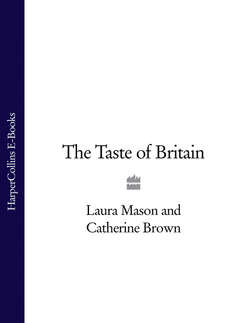Читать книгу The Taste of Britain - Hugh Fearnley-Whittingstall - Страница 70
HISTORY:
ОглавлениеOne element of the history of brawn is constant right down to the present day and this is not the composition of the dish itself but the habit of serving it with mustard. ‘Furst set forth the mustard and brawne of boore ye wild swyne,’ instructed the Boke of Nurture in 1460.
‘Good bread and good drinke,
a good fier in the hall,
brawne, pudding and souse,
and good mustard withall’
was Thomas Tusser’s (1573) prescription for a husbandman’s Christmas. Later recipes for brawn sauce made of mustard, sugar and vinegar abound (e.g. Dallas, 1877).
Brawn originally meant muscle or meat of any description; by the fifteenth century the word was particularly, although not exclusively, associated with the flesh of wild boar. The Tudor physician Thomas Cogan stated that the flesh of wild swine was better for you than any tame animal and that brawn, which is the flesh ‘of a boare long fedde in the stie,’ was difficult of digestion. He counselled that it should be eaten at the start of a meal - advice that seems to have been followed, even if unconsciously, unto the present day (O’Hara May, 1977). Because the word applied exclusively to flesh or muscle meat, it followed that brawn developed the restricted meaning of the boned flesh, fat and skin, as opposed to the whole joint, bone-in. The way such a floppy joint was best dealt with was that it would be collared. It would be rolled up tight, wrapped in cloth and tied round [collared] with tape or string before boiling. Collaring was normally done to sides of pig, rather than hams. In the sixteenth-century accounts of the Star Chamber brawn appears almost monotonously as collars or rounds. Martha Bradley (1756) has instructions on choosing brawn. Her definition of the word was meat that came from an uncastrated boar (not necessarily wild). The best was from a young animal: old boar was too tough and the rind too thick, meat from a sow too soft. Her namesake, Richard Bradley, writing 20 years earlier (1736), disagreed. His brawn was the collared flitches of ‘an old boar, for the older he is, the more horny will the brawn be’. He thought brawn rather insipid; horny was probably a good thing.
A collar was a convenient package that could be cooked and sliced. The method was also a way of preserving unwieldy and quick-spoiling food, in other words, pickling. Collared meats (and fish) were usually brined and spiced, boiled, pressed and sliced. Brawn came to mean almost exclusively pork cooked in this manner. If the meat was pressed and cooled in its liquor, it would indeed begin to look like the jellied brawn we have today.
Whereas at the outset brawn applied to most parts of the pig apart from the valuable hams, by the 1800s, in the southern part of England, it had come to mean a dish based on pigs’ heads, collared. This appears under the tide ‘Tonbridge Brawn’ in Eliza Acton (1845). As the head was the boniest (and least vendible) part of the animal, it was a natural candidate for collaring and repackaging, leaving the rest for bacon, ham or roasting joints. A dish that was also common in Georgian recipe books was ‘mock brawn’: a flank of pork rolled around morsels from calves’ feet and pig’s head, cooked, pressed and cooled. Gradually, as brawn was relegated to a dish of the poor and country people who killed their own pigs, the dish was simplified into a highly seasoned, moulded, meat jelly containing small pieces of pork
Pork cheese, once commonly termed head cheese, is a similar dish made from finely minced meat rather than chopped scraps. In some regions, especially the North, brawn-type dishes are made from beef.
Brawn is still widely made, and is a profitable by-product of pork butchery. It is a component of salad lunches and still eaten with mustard or strong condiments. Although it may be found in many parts of the country, it is most often sold in the South West, where a number of relics of a once important industry survive, such as Bath chaps, chitterlings and the like.
